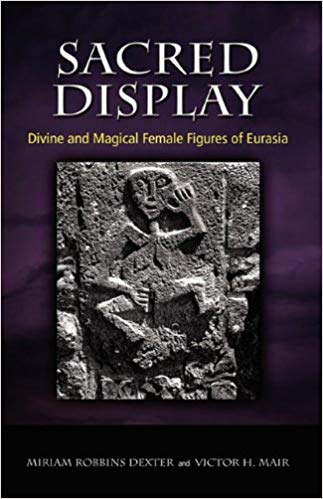Sacred Display: Divine and Magical Female Figures of Eurasia

Victor H. Mair
http://www.cambriapress.com/books/9781604976748.cfm
Written by Miriam Robbins Dexter and Victor H. Mair
This book discusses erotic and magical goddesses and heroines in several ancient cultures, from the Near East and Asia, and throughout ancient Europe; in prehistoric and early historic iconography, their magical qualities are often indicated by a magical dance or stance. It is a look at female display figures both cross-culturally and cross-temporally, through texts and iconography, beginning with figures depicted in very early Neolithic Anatolia, early and middle Neolithic southeast Europe––Bulgaria, Romania, and Serbia––continuing through the late Neolithic in East Asia, and into early historic Greece, India, and Ireland, and elsewhere across the world. These very similar female figures were depicted in Anatolia, Europe, Southern Asia, and East Asia, in a broad chronological sweep, beginning with the pre-pottery Neolithic, ca. 9000 BCE, and existing from the beginning of the second millennium of this era up to the present era.
The authors find several new cross-cultural reference points to a group of related female figures. In comparing written descriptions of these female figures, the authors examine texts from the Old Irish tale, “The Destruction of Da Derga’s Hostel,” the text of an erotic Scandinavian story and a text describing the birth of Kali. The iconography of these female figures depicts a similar “crouching” or “bent-knee” position. Old Irish and Greek texts describe the act of "anasyrma," a woman's lifting up of her skirt to boldly display her genitals, in order to frighten off an enemy.
Parallels to these terrifying, yet empowering, figures in Anatolia, Europe, the Middle East, and South Asia are enigmatic Central Asian and East Asian representations of women exposing themselves, some of which go back to as early as the third millennium BCE. One particularly curious aspect of the motif of female sexual exposure is that it can occur both in East Asia and Europe in the context of war, either to frighten the enemy or to embolden one's own troops.
This book demonstrates the extraordinary similarities, in a broad geographic range, of depictions and descriptions of magical female figures who give fertility and strength to the peoples of their cultures by means of their magical erotic powers. This book uniquely contains translations of texts which describe these ancient female figures, from a multitude of Indo-European, Near Eastern, and East Asian works, a feat only possible given the authors' formidable combined linguistic expertise in over thirty languages. The book contains many photographs of these geographically different, but functionally and artistically similar, female figures. Many current books (academic and otherwise) explore some of the female figures the authors discuss in their book, but such a wide-ranging cross-cultural and cross-temporal view of this genre of female figures has never been undertaken until now.
The “sexual” display of these female figures reflects the huge numinosity of the prehistoric divine feminine, and of her magical genitalia. The functions of fertility and apotropaia, which count among the functions of the early historic display and dancing figures, grow out of this numinosity and reflect the belief in and honoring of the powers of the ancient divine feminine.
